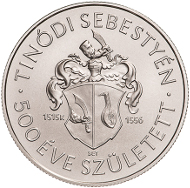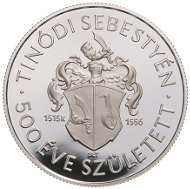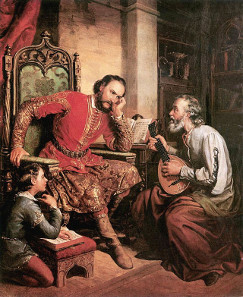April 23, 2015 – The Magyar Nemzeti Bank honours the great Hungarian chronicler Sebestyén Tinódi by issuing a collector coin. The coin was designed by Tamás E. Soltra.
Hungary / 2015 / 2,000 forint / CuNi / 37 mm / 23.7 g / Design: Tamás E. Soltra / Mintage: 5,000.
The front of the coin depicts the rosette ornament of a lute, while the reverse has Tinódi’s coat of arms, with the sword symbolising his youthful gallantry and the lute as the inseparable accompaniment to his songs.
Sebestyén Tinódi (around 1510-1556)
We know very little of the life of Sebestyén Tinódi, and his date of birth is uncertain. What we do know stems mostly from his poems, although these must sometimes be taken with some reservations. At the very beginning of his career, he served in the court of Bálint Török. After his lord was captured in 1541, he was without a patron, and towards the end of the 1540s he settled with his family in Kassa (present-day Košice/Slovakia). Elevated to noble rank in 1553 by Ferdinand I, he published his work Cronica in 1554 in Kolozsvár (present-day Cluj-Napoca/Romania) with the Emperor’s support. This made him a unique figure in Hungarian literature, because never before had anyone compiled a volume of works by an author. He visited the court of Tamás Nádasdy in 1556 and died at the end of January in the town of Sárvár.
Hungary / 2015 / 10,000 forint / Ag .925 / 37 mm / 24 g / Design: Tamás E. Soltra / Mintage: 5,000.
While we generally think of Tinódi as the author of historical songs, some of his works from other genres have also been preserved. Two of his stories are biblical in nature (Dávid király mint az nagy Góliáttal megvíutt; Judit asszony históriája), one deals with mythology (Jázonról és Médeáról), and three of his poems cannot be classed as historical songs (Sokféle részögösröl; Az udvarbírákról és kulcsárokról; Hadnagyoknak tanúság, mikor terekkel szömbe akarnak öklelni). Most of his work takes the form of chronicles, i.e. stories in verse form about current events, in particular the battles against the Turks. Some of these chronicles were written just weeks after the actual events occurred. These works provide a gold mine of detailed information for historians. This form of chronicle song was almost unique to Tinódi and he is the only poet who had an independent edition of his works published in that century. Consequently, he differed greatly from his contemporaries, who mainly chronicled historical events and biblical themes. Most of Tinódi’s work we know from Cronica. It is certain that this volume only contains a fraction of his life’s work, and the pieces selected for this composition only represent a small portion of a much richer body of poetry and complex set of genres.
Palatin Nádasdy and Tinódi by Soma Orlai Petrics, 1855. Source: Wikipedia.
Although he was a writer and publisher of sheet music, in some of his poems (Dávid király…; Sokféle részögösröl), Tinódi writes his part as equal with the violins, i.e. he makes no distinction between himself and them. The melodies for his chronicles were taken from the motifs of contemporary lute music, and he published these together with the sheet music, providing a valuable source for music historians.
Tinódi’s works made a huge impression on his peers (Mátyás Csabai, Miklós Istvánffy, et al), and several ballads of János Arany are based on his themes (Szondi két apródja, Török Bálint). The broader public came to know the poet’s works through Géza Gárdonyi’s novel “Eclipse of the Crescent Moon” which was based to a large degree on his chronicles. Tinódi even features in a minor role in the story.
Source: Magyar Müvelödéstörténeti Lexikon: Középkor és kora újkor, XII, ed. PÉTER KÖSZEGHY, Bp., Balassi, 2011, 53–54., based on Balázs Pap.
The website of the Magyar Nemzeti Bank you may find here.
In this Youtube video you can hear one of the songs of Sebestyén Tinódi.









